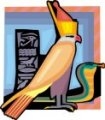
Worksheets and No Prep Teaching Resources
Reading Comprehension Worksheets
Ancient Egypt

Ancient Egypt
 Worksheets and No Prep Teaching Resources Reading Comprehension Worksheets Ancient Egypt |
 Ancient Egypt |
| edHelper's suggested reading level: | grades 8 to 9 | |
| Flesch-Kincaid grade level: | 7.68 |
|
Hatshepsut
By Phyllis Naegeli |

|
 1 In Egypt, most pharaohs were men. Fathers usually passed on the throne to the firstborn son of their favored wife. However, Hatshepsut was the first of a few exceptions. She was an ambitious woman who ruled Egypt for twenty years. In a society where the leaders had always been male, how did this happen?
1 In Egypt, most pharaohs were men. Fathers usually passed on the throne to the firstborn son of their favored wife. However, Hatshepsut was the first of a few exceptions. She was an ambitious woman who ruled Egypt for twenty years. In a society where the leaders had always been male, how did this happen? |
Create Weekly Reading Books
Prepare for an entire week at once! |
| Leave your feedback on Hatshepsut (use this link if you found an error in the story) |
 |
Ancient Egypt
|
 |
High School Reading Comprehensions and High School Reading Lessons
|
 |
Social Studies
|